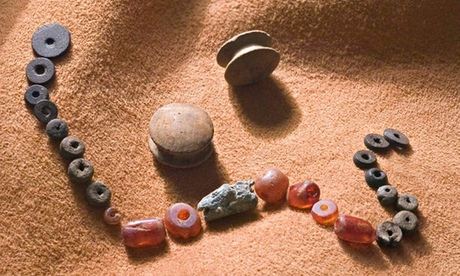4,000-year-old Dartmoor burial find rewrites British bronze age history

Parts of a necklace and wooden ear studs found on Dartmoor
Some 4,000 years ago a young woman's cremated bones – charred scraps of her shroud and the wood from her funeral pyre still clinging to them – was carefully wrapped in a fur along with her most valuable possessions, packed into a basket, and carried up to one of the highest and most exposed spots on Dartmoor, where they were buried in a small stone box covered by a mound of peat.
The discovery of her remains is rewriting the history of the bronze age moor. The bundle contained a treasury of unique objects: a tin bead and 34 tin studs, which are the earliest evidence of metal-working in the south-west; textiles, including a unique nettle fibre belt with a leather fringe; jewellery, including amber from the Baltic and shale from Whitby; and wooden ear studs, which are the earliest examples of wood turning ever found in Britain.
The site chosen for her grave was no accident. At 600 metres above sea level, White Horse hill is so remote that getting there even today is a 45-minute walk across heather and bog, after a half-hour drive up a military track from the nearest road. The closest known prehistoric habitation site is far down in the valley below, near the grave of the former poet laureate Ted Hughes.
http://www.theguardian.com/science/2014/mar/09/dartmoor-burial-site-bronze-age-history?CMP=fb_gu
